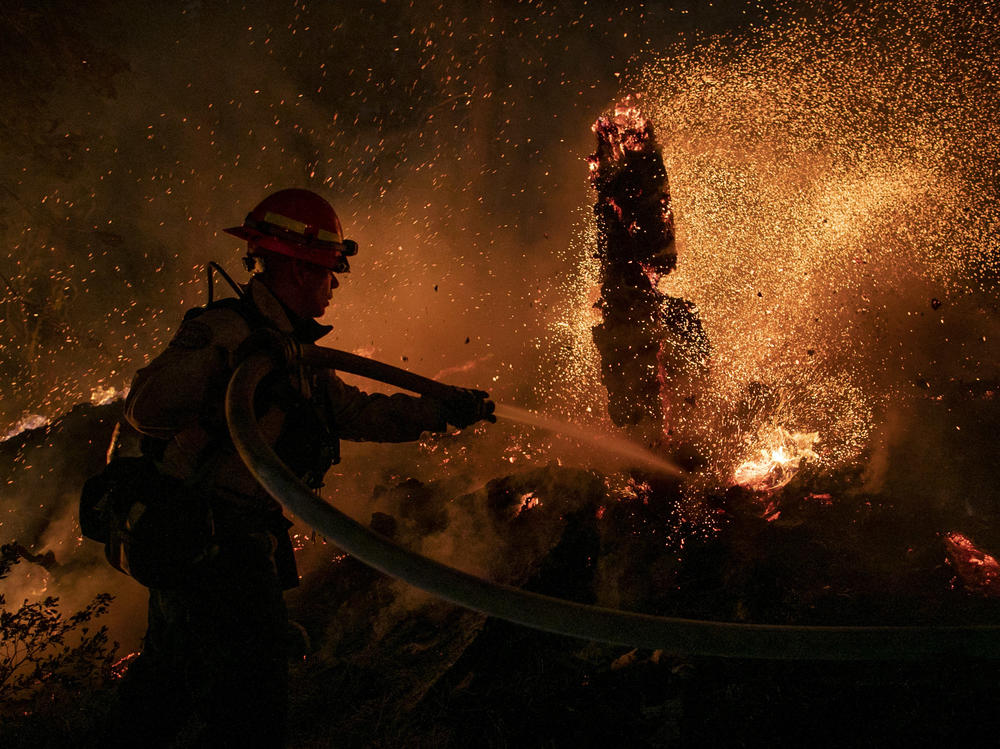Section Branding
Header Content
Weather Disasters Have Become 5 Times As Common, Thanks In Part To Climate Change
Primary Content
Climate change has helped drive a fivefold increase in the number of weather-related disasters in the last 50 years, according to a new report published by the U.N. agency the World Meteorological Organization.
About 11,000 disasters were documented between 1970 and 2019 from weather events, water hazards and climate extremes, according to the report. The disasters were responsible for 2 million deaths and $3.6 trillion in losses, the WMO estimated. More than 91% of those deaths occurred in developing countries.
The WMO report said that of the 77 weather-related disasters documented between 2015 and 2017, 62 showed a significant human influence. In a statement accompanying the report's release, WMO Secretary-General Petteri Taalas warned that, as the world continues to warm, those totals will climb.
"That means more heat waves, drought and forest fires such as those we have observed recently in Europe and North America. We have more water vapor in the atmosphere, which is exacerbating extreme rainfall and deadly flooding," Taalas said. "The warming of the oceans has affected the frequency and area of existence of the most intense tropical storms."
The report arrives against the backdrop of numerous alarms being sounded about climate change. Extreme weather has hammered communities from the Pacific Northwest to Siberia to China. A major climate report issued in August by the U.N.'s climate body found that global warming is accelerating, and human activities are its biggest driver. On Monday, more than 200 medical and health journals around the world issued an unprecedented joint statement declaring that the greatest health crisis humanity faces is climate change, not the pandemic.
The two deadliest extreme-weather events, a 1983 Ethiopian drought and a 1970 tropical cyclone in Bangladesh, each resulted in an estimated 300,000 deaths, according to the report on disasters.
The United States has incurred the biggest economic losses from weather-related disasters. The five costliest disasters are all hurricanes that made landfall in the U.S. in the last two decades, led by Hurricane Katrina in 2005, which inflicted an estimated $164 billion in damages and killed more than 1,800 people.
The second, third and fourth costliest storms all occurred in 2017: Hurricanes Harvey, Maria and Irma.
The report also noted that some of the documented increase in frequency is the result of improved disaster reporting.
Weather-related disasters have become much less deadly
Despite the increasing frequency and severity of disasters, there is some reason to hope.
Thanks to improvements in early warning systems and better disaster management, deaths from these disasters have decreased nearly threefold in the last five decades.
In the 1970s, an average of 50,000 people died annually from weather-related disasters, the report said. By the 2010s, the annual number was below 20,000.
"Quite simply, we are better than ever before at saving lives," Taalas said.
But there's still a lot of room for improvement. Dozens of countries in the developing world still lack adequate early warning systems, and there are major gaps in data-collection networks across Africa, Latin America and the Caribbean. That makes it more difficult to prepare adequately for coming disasters and increases the risk of fatalities.
Hundreds of millions likely to be displaced by extreme weather
Those worsening disasters have consequences that extend beyond the loss of life and economic toll as climate change threatens to make some parts of the world unlivable.
Mami Mizutori, a U.N. official in charge of the Office for Disaster Risk Reduction, said that though the world may now be better equipped to prevent fatalities, population growth and the increasing intensity and frequency of weather events have led to a displacement crisis.
"More international cooperation is needed to tackle the chronic problem of huge numbers of people being displaced each year by floods, storms and drought," she said. "We need greater investment in comprehensive disaster risk management ensuring that climate change adaptation is integrated in national and local disaster risk reduction strategies."
The Institute for Economics and Peace estimated last year that 1.2 billion people are at risk of being displaced by climate change by 2050.
Things will get more severe as climate change continues
The report's release coincides with severe weather dominating headlines across the globe.
In the United States, Hurricane Ida and its remnants brought catastrophic damage and rain first to the Gulf Coast and then across the Mid-Atlantic and Northeast. The storm — blamed for more than 60 deaths — triggered the first flash-flood emergency ever issued for New York City.
In the American West, wildfires dominate the landscape, and much of the region is struggling with drought.
And unless dramatic action is taken to halt greenhouse gas pollution and limit future warming, weather-related disasters will continue to grow both more frequent and more severe — with more disasters happening simultaneously.
Copyright 2021 NPR. To see more, visit https://www.npr.org.

